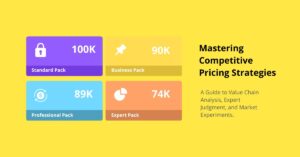
In an era where data-driven decision-making is paramount, understanding and implementing advanced demand forecasting in supply chain management is crucial. At Thriveark, we believe in empowering businesses with cutting-edge machine learning (ML) techniques to predict market demands accurately. This comprehensive guide delves into various ML methods, focusing on accessible tools and platforms, to revolutionize your approach to demand forecasting.
Fundamentals of Demand Forecasting in Supply Chain
The Essence of Demand Forecasting
Demand forecasting is the art and science of predicting future customer demand. It’s a pivotal component in supply chain management, influencing inventory control, production planning, and overall business strategy.
Why Accurate Forecasting Matters
The ability to accurately forecast demand dictates the efficiency of the supply chain. It reduces inventory costs, minimizes stockouts or overstock situations, and ensures timely fulfillment of customer orders. In a nutshell, it’s about having the right products, in the right quantity, at the right time.
The Role of Machine Learning in Enhancing Forecasting Accuracy
The Advent of Machine Learning in Forecasting
Traditional statistical methods are giving way to ML models, which offer greater precision and adaptability. ML algorithms can uncover complex patterns in historical data, making predictions more nuanced and dynamic.
Pioneering Algorithms for Demand Forecasting
Time Series Models: The backbone of demand forecasting, focusing on data indexed in time order.
ARIMA (AutoRegressive Integrated Moving Average): Best for linear, non-seasonal time series.
Prophet by Facebook: Designed for daily observations with strong seasonal patterns. It’s robust to missing data and shifts in the trend.
Recurrent Neural Networks (RNNs): Ideal for capturing nonlinearities in data, especially Long Short-Term Memory (LSTM) networks, adept at learning long-term dependencies.
Leveraging AWS for Sophisticated Demand Forecasting

Navigating AWS Services
Amazon Web Services offers an array of services that simplify the adoption of ML in demand forecasting.
Amazon Forecast: A Beginner’s Best Friend
A fully managed service, it’s perfect for those starting their journey in ML. It auto-selects the best algorithm and handles the data processing and model training.
Use Cases: Ideal for businesses with limited ML expertise but needing reliable forecasts.
Amazon SageMaker: For the ML Enthusiasts
Offers extensive customization and control, suitable for more complex forecasting requirements.
Requires foundational knowledge in ML and data science, but it’s a powerful tool for those looking to dive deeper.
Exploring Advanced Forecasting with LSTNet and DeepAR
LSTNet (Long- and Short-term Time-series Network)
What It Is: Available in the GluonTS Python package, LSTNet is designed to capture intricate patterns in time series data.
How It Works: It employs a mix of CNNs and RNNs, making it adept at handling datasets where both long-term trends and short-term fluctuations are crucial.
Practical Use: LSTNet is particularly useful when dealing with multifaceted datasets, where standard models might fail to capture all underlying patterns.
DeepAR: Amazon SageMaker’s Powerhouse
Overview: A SageMaker-native algorithm, DeepAR, stands out for its ability to forecast time series with improved accuracy.
Mechanism: It uses past data points to predict future ones, learning from trends across multiple time series.
Application: DeepAR is a game-changer for businesses with multiple, interrelated time series data, common in larger supply chains.
Hands-On Application: Utilizing Sample Datasets for Learning
The Value of Sample Datasets
Purpose: They allow beginners to grasp the fundamentals of ML models without the initial complexity of their data.
Sources: AWS and GluonTS offer built-in datasets, and platforms like Kaggle provide a diverse array of real-world datasets.
Step-by-Step Guide to Using Sample Datasets
Data Exploration: Start by understanding the dataset – its variables, range, and historical patterns.
Model Training: Apply models like LSTNet or DeepAR to these datasets. This step helps in grasping how different models behave with varying data types.
Performance Evaluation: Use metrics like MAPE or RMSE to gauge the model’s accuracy.
Benchmarking and Learning: Compare your outcomes with established benchmarks on Kaggle to understand where your model stands and areas for improvement.
Translating to Real-World Data: Once comfortable, transition to using your own supply chain data, applying the insights and techniques learned.
Conclusion
Mastering ML-based demand forecasting is a journey of continuous learning and adaptation. In supply chain management, the ability to predict future demands accurately can significantly enhance operational efficiency and customer satisfaction.
At Thriveark, we specialize in guiding businesses through this journey, offering expertise in implementing and optimizing ML models for demand forecasting. Whether you’re taking your first steps in ML or seeking to refine your existing models, we’re here to assist.
Connect with Thriveark today to explore how we can help you leverage ML for superior demand forecasting and transform your supply chain management.


